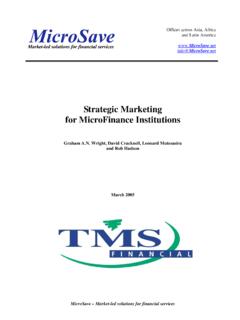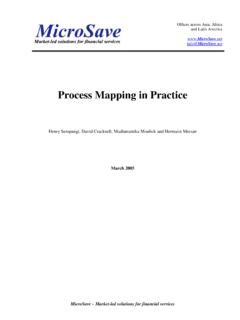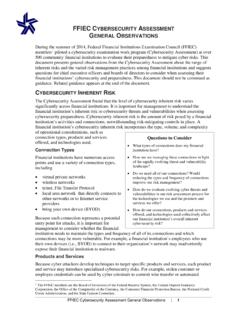Transcription of Strategic Business Planning for Market-led Financial ...
1 MicroSave - Market-led solutions for Financial services Offices across Africa, Asia and Latin America Strategic Business Planning for Market-led Financial Institutions Toolkit Graham Wright, Kasia Pawlak, Walter Tounitsky, Lisa Parrott, David Cracknell and Ramesh S. Arunachalam Version 0707 Strategic Business Planning for Market-led Financial Institutions Wright et al. MicroSave - Market-led solutions for Financial services ii Introduction ..1 Table of Contents Introduction to Strategic Business Planning .
2 1 What Is Strategic Business Planning ?.. 1 Strategic Business Planning - Purpose and Benefits .. 1 So What s New? We Do Planning Anyway .. 1 What Are The Benefits of Strategic Business Planning ? .. 1 Factors That Contribute To Success .. 3 What Is The Right Way To Conduct Strategic Planning ? .. 3 How Do We Organise The Planning Process?.. 4 Who Should Be In The Strategic Business Planning Team? .. 5 Strategy .. 6 What Is Strategy? .. 6 How Does It Relate To Other Components? .. 7 Information to Develop the Strategy.
3 9 How Does Operational Effectiveness and Strategy Correlate? .. 9 Overview of the Strategic Business Planning Process .. 10 What Is MicroSave s Approach To Strategic Business Planning ? .. 10 What Are The Nineteen Steps In Strategic Business Planning .. 11 Mission, Values and Vision ..12 Step 1: Define The Organisation s Mission .. 12 Step 2: Identify The Organisation s Values .. 13 Step 3: Define Your Organisation s Vision .. 14 Diagnose Current Strategic Position ..17 Step 4: Conduct market Analysis.
4 17 What Information To Gather?.. 18 What Is market Segmentation?.. 18 Why Segment Your market ? .. 18 How To Segment Your market ? .. 19 What Do I Do With market Segments Once I Have Them? .. 20 Step 5: Conduct Competition Analysis .. 21 How Do Identify My Real Competitors? .. 21 How Do I Competition Analysis? .. 22 How Should I Formulate Strategy Towards The Competition? .. 25 How Do We Get This Information on Our Customers and Competitors? .. 26 Step 6: Conduct Institutional Analysis .. 26 Step 7: Conduct Sector and Macro-environment Analysis.
5 27 What Is Sector Analysis? .. 27 What Is PEST Analysis? .. 27 Formulate Your Strategy ..29 Step 8: Pull It Together With SWOT .. 29 Step 9: Formulate Your Strategy .. 30 How Do I Formulate Strategy From All This Information? .. 30 How Do I Plan My Future market And Scope?.. 30 And What About the Value Proposition? .. 31 And My Competitive Advantage/Strategy? .. 32 Can You Give Me Some Examples Of Strategies?.. 32 Must I Differentiate My Institution? .. 33 Develop The Financial Projections.
6 34 Step 10: Develop Financial Projections .. 34 Execute Your Strategy Through KOGMA Analysis ..35 Overview of KOGMA Analysis .. 35 Why Do Strategies (So Often) Fail? .. 35 What Is KOGMA Analysis? .. 35 Strategic Business Planning for Market-led Financial Institutions Wright et al. MicroSave - Market-led solutions for Financial services iii Step 11: Identify Key Objectives .. 40 How Do I Identify Key Objectives? .. 40 Can You Give An Example? .. 40 How Do I Move From Critical Issues To Key Objectives?
7 41 How Do Ensure That My Key Objectives Are Clear Enough?.. 42 Step 12: Set Goals .. 43 Step 13: Select Measures .. 43 Why Measure Performance? .. 43 What Are The Categories Of Performance Measures? .. 44 So Which Measures Should I Choose? .. 46 Step 14: Set Targets .. 47 How Do I Set About Benchmarking? .. 47 How Do I Set Performance Targets? .. 47 Step 15: Translate Targets to Reality: Define Activities .. 49 How Do I Define Activities? .. 49 How Do I Assess And Prioritise Activities?
8 49 How Do I Budget For All These Activities? .. 50 Step 16: Re-visit Your Financial Projections .. 52 Implement and Monitor KOGMA Analysis ..53 Step 17: Communicate! .. 53 How Do I Communicate And market The Plan? .. 53 What Is Cascading? .. 53 Step 18: Reporting, Use & Learning KOGMA .. 55 How Do I Use Tracking Systems? .. 55 How Do I Monitor The Measures? .. 55 And What About Reporting The Results? .. 56 What Should We Do In The Review Meetings? .. 57 Can We Base Rewards on Overall Results?
9 57 Step 19: Review Update Your KOGMA Analysis .. 58 Annual Review and Assessment .. 58 KOGMA Implementation Principles Lessons Learnt from Other Industries .. 59 Strategic Business Planning for Financial Institutions Toolkit - Wright et al. MicroSave Market-led solutions for Financial services 1 Introduction Introduction to Strategic Business Planning What Is Strategic Business Planning ? Strategic Business Planning is a disciplined and pragmatic approach that organisations can use to make decisions now about the future.
10 It enables them to make more informed choices and decisions, set future directions, establish priorities, allocate limited resources, improve operations and monitor results. It is also a process of organisational self-assessment, goal setting, strategy development and performance monitoring. In the Planning process, Financial institutions determine (or review) their core functions and objectives/goals within the context of trends in the external environment, their internal capacities as organisations and their missions.












